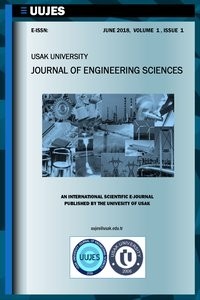LABOR EFFICIENCY: A STUDY IN THE PAPER MILL
LABOR EFFICIENCY: A STUDY IN THE PAPER MILL
Business, efficiency, input-output labor, paper industry,
___
- Apostolides, A. A Primer on Multifactor Productivity: Description, Benefits and Uses”, U.S. Department of Transportation Research and Innovative Technology Administration Bureau of Transportation Statistics Office of Advanced Studies, https://www.bts.gov/sites/bts.dot.gov/files/docs/browse-statisticalproducts-and-data/bts- publications/201991/multifactor-productivity.pdf; 2008.
- Propenko, J. Productivity Management – Practical Handbook, (Translation Olcay Baykal et al.), National Productivity Center publications, Ankara; 1998.
- Alpagun, O. Business Economics and Management, Beta publications, İstanbul; 1995.
- Dinçer, Ö. and Fidan, Y. Introduction to Business Management, Business Publications, Istanbul; 1995.
- Metin, E. The Effects of Social Entropy on Productivity, Journal of Cumhuriyet University Faculty of Economics and Administrative Sciences, 2001; 2(1):127-143.
- Çayır, Ü. Some Factors Affecting the Work Efficiency of Coal Workers, Hacettepe University Institute of Social Sciences, M.Sc., Ankara; 1991.
- Özden, C. M. Professional Preferences of Qualified Employees, National Productivity Center publications, 2001; 3:33-58.
- Pfeffer, J. The Secret of Competitive Advantage: Human, (Trans. S. Gül), Sabah bookstore, İstanbul; 1995.
- Örücü. E. and Kanbur, A. An Empirical Study to Examine the Effects of Organizational-managerial Motivation Factors on The Performance and Productivity of Employees: Service and industry business example, Management and Economics, 2008; 15 (1):85-97.
- Koçel, T. Business Management: Management and Organization, in Organizations. Behavior, Classical-Modern-Contemporary and Current Approaches, Istanbul: Beta Publishing House, 2014.
- Koçak, A. and Ayluçtarhan, H. A Computer-aided System Model Based on Productivity and Quality in Ready-made Garment Businesses, Third Sector Social Economic Review, 2022; 57(3):1805-1823.
- Özdamar, S. “Evaluating Our Manpower Potential in The Most Efficient Way Is Among Our Priority Goals”, Employer Magazine, 1998; 8.
- Yumuşak, S. A case study to analyze the factors impacting employee efficiency, Suleyman Demirel University The Journal of Faculty of Economics and Administrative Sciences, 2008; 13(3):241-251.
- Demirci, B., Kılıç, Ö. and Özhasar, Y. The Effect of Nomophobia on Employee Productivity in Food and Beverage Businesses, Journal of Business Research Turk, 2021; 13(4):3514-3524.
- Demir, M. The Effects of Ergonomics on Employee Efficiency in Hospitality Businesses, The Journal of Industrial Relations and Human Resources, 2003; 5(2).
- Dulkadir, B. Loss of Productivity Based on Shifts of Groupings in Business the Effect of Data Mining Method, International Journal of Social Humanities Sciences Research, 2018; 27:2737-2745.
- Turgut, O. and Dalay, İ. A. Factor to be Considered in the Labor Efficiency Account: The Financial Health Status of the Employees, Social Mentality and Researcher Thinkers Journal, 2020; 6(38):2252-2262.
- Kara, M. and Seyhan, M. The Concept of Efficiency and The Importance of Efficiency in Businesses: The Example of AKFA Tea Factory, International Journal of Academic Value Studies, 2016; 2(4):161-169.
- Tütüncü, A., Bayraktar, Y. And Gönülaçan, A. The Relationship Between Ergonomic Workplace and Productivity: A Research on Academic Staff of Karadeniz Technical University, Journal of Economics and Administrative Sciences Faculty, 2020; 7(1):93-117.
- Roelofsen, P. The Impact of Office Environments on Employee Performance: The Design of the Workplace as a Strategy for Productivity Enhancement. Journal of Facilities Management, 2002; 1:247-264.
- Çakırel, Y., Karaca, P. Ö., Çakırel, A. Ö. and Çakır, İ. A Study on The Assignment of the Breaus of Vocational High School Students in Terms of Ergonomics-Performance, Journal of Suleyman Demirel Universty Institute of Social Sciences, 2013; 26:23-40.
- Koçer, S., Yazıcı, T. and Ekinci, D. K. A Study Relating of Office Environments on Workers: Kocaeli Metropolitan Municipality Sample, Gümüşhane University E-Journal of Faculty of Communication, 2016; 4(2):554-586.
- Hayta, B. A. The Effect of The Working Environment Conditions to Management Fertility, Journal of the Faculty of Commerce and Tourism Education, 2007; 1:21-41.
- Çelebi, E. S. Effects of Ergonomic Improvements on Work Psychology and Productivity: A Study in an Electrical Home Appliances Manufacturer, Journal of Life Economics, 2018; 5(1):83-94.
- Anonymous1. https://www.medhesap.com/orneklem-boyutu-hesaplama/2023
- Kline, R. B. Principles and Practice of Structural Equation Modeling. Guilford Press, New York, 2011.
- Kunnan, A. J. An Introduction to Structural Equation Modelling for Language Assessment,. Research. Language Testing, 1998; 15(3):295–332.
- Güngör, M. and Bulut, Y. On The Chi-Square Test, Fırat University Journal of Oriental Studies, 2008; 7(1):84-89.
- Başlangıç: 2018
- Yayıncı: Uşak Üniversitesi
EARTHQUAKES AND DISASTER EDUCATION IN OUR COUNTRY AND IN THE WORLD
Halil İbrahim YÜKSEL, Erten AKBEL
Necla YAMAN TURAN, Mehmet Ali ÇOKYİĞİT
THERMAL AND MECHANICAL PROPERTIES OF CONCRETES CONTAINING POLYPROPYLENE, KAPOK AND COCONUT FIBERS
Hakan SARIKAYA, Gülşah SUSURLUK
